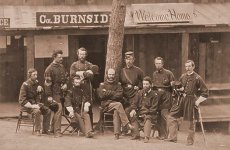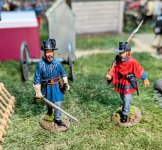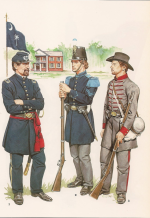Stacie
Private
- Joined
- Feb 24, 2022
- Messages
- 11
JJDESIGNS NEWS UPDATE 7th JULY 2025
THE AMERICAN CIVIL WAR
THE FIRST BATTLE OF BULL RUN 1861.
1st REGIMENT, RHODE ISLAND DETACHED MILITIA, 1861
In the days following the outbreak of war, Northern states scrambled to buttemble small militia groups into regiment-size units, recruit additional volunteers and uniform them all in a cohesive manner. Rhode Island was no exception with the added problem of having no official state uniform for its troops. Ambrose Everett Burnside, former major general in the state’s militia, returned from his job as a N.Y. City banker and stepped up to the task of equipping and organizing the troops.

On April 20, just five days from Lincoln’s call for 75,000 troops for three months service, the First Rhode Island Detached Militia departed for Washington D.C., led by Col. Burnside himself. On July 16 the unit left camp outside the capital with the bulk of the Union Army and five days later met the Confederate forces at Manassas, Va.
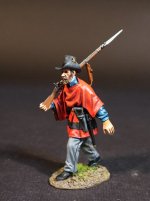
With summer approaching, and expectations that the war would be short, uniforms were lightweight, with little attention to durability. Designed by Col. Burnside and inspired by the “hunting shirts” worn by many Continentals during the American Revolution, the blue flannel pullover blouse was simple and easily made by the ladies in Providence. Single breasted for line officers and enlistees, double breasted for staff.
The most distinguishing item of gear was a bright red woolen blanket. Burnside personally superintended the manufacture of the uniform,
“He had the thick scarlet blanket of each man converted into a Mexican poncho, by cutting a slit in the centre through which the head could be put, leaving the blanket resting as a cloak on the shoulders”.
A waistbelt with cartridge box and cap box, a white canvas haversack for rations and a tin canteen completed the kit.
The Regiment served in Burnside’s Brigade at First Bull Run, taking an early part in the action. For a time it stood up well, but after two or three hours of heat and combat it fell to pieces and was of little value afterwards
AMBROSE EVERTS BURNSIDE (May 23rd 1824 – September 13rth 1881) was an American army officer and politician who became a senior Union general in the American Civil War and a three time Governor of Rhode Island, as well as being a successful inventor and industrialist.
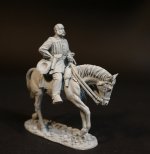
At the outbreak of the civil War, Burnside was a colonel in the Rhode Island Militia. He raised the 1st Rhode Island Volunteer Infantry Regiment, and was appointed its colonel on May 2nd 1861. Two companies of this regiment were then armed with Burnside carbines.
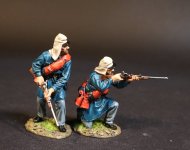
Burnside was a modest and unassuming individual, mindful of his limitations, who had been propelled to high command against his will. He could be described as a genuinely unlucky man, both in battle and in commerce (he was cheated of the profits of a successful cavalry firearm that had been his own invention).
His spectacular growth of whiskers became known as “sideburns”, deriving from the two syllables of his surname.
KADY BROWNELL
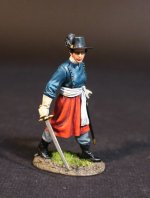
Kady Brownell was one of at least three “vivandieres” known to have been attached to this regiment.
She joined with her husband Robert, and Colonel Ambrose Burnside the regiment’s commander appointed her a Daughter of The regiment, and colour bearer.
Kady Brownell was an active participant in the First Battle of Bull Run in 1861, and at the Battle of New Bern in 1862 after she and her husband re-enlisted with the 5th Rhode Island Infantry.
2nd WISCONSIN INFANTRY REGIMENT, FIRST BULL RUN 1861
At the outset of the Civil War, both sides faced the challenge of equipping a large number of soldiers in a short amount of time. Often, this meant furnishing the men with local militia uniforms, regardless of the colour. When the first large scale battle occurred at First Bull Run in Virginia in July of 1861, some Union troops like the 2nd Wisconsin Infantry wore grey uniforms, while some Confederates were clad in blue. This led to predictable confusion–and casualties–on the battlefield
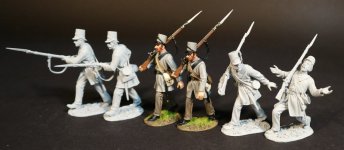
On the afternoon of July 21st, 1861, the 2nd Wisconsin was brigaded with the 13th, 69th and 79th New York Infantry regiments, and a battery of artillery under the command of Colonel William T. Sherman. The brigade was ordered to attack Henry Hill, the scene of much intense fighting that day. The 2nd Wisconsin was positioned along the Sudley Road when the order came to advance to the east and up Henry Hill. The regiment began taking fire from the top of the hill. The fire was returned but “it was impossible to push our line forward against the evidently superior forces massed in our front” recalled Captain Thomas Allen.
The 2nd Wisconsin began to slowly fall back. As they did so, they were hit by fire from the rear. Other union troops from the brigade mistook them for Confederates after seeing the regiment’s gray uniforms. Officers scrambled to stop the shooting, and the 2nd Wisconsin returned to its starting point along the road.
Ordered forward again, the 2nd Wisconsin advanced on the double quick up Henry Hill and fired at the enemy at the top. A Confederate flag was visible at the top of the hill, but in the smoke from the gunfire, it was easily confused for a U.S. flag. Shouts went out that the Wisconsin men were firing at their own soldiers. The 2nd Wisconsin held its fire and slowed its advance up the hill. Confederate defenders then opened a devastating fire on the advancing Federals.
With no reinforcements supporting them, the men of the 2nd Wisconsin retreated back down hill in disorder. When they came into view of the 69th and 79th New York regiments, the New Yorkers again thought the gray uniformed soldiers were Rebels and opened fire. More Wisconsin men went down before they were identified and reached safety.
The 2nd Wisconsin lost 23 men killed, 65 wounded, and 63 missing at the First battle of Bull Run. Though it is not known how many, at least some of these were due to the confusion caused by their gray uniforms. Soon, those uniforms would be replaced and the in the Fall of 1861, the 2nd Wisconsin would be brigaded with the 6th and 7th Wisconsin, and 19th Indiana Infantry regiments to form what would later be called the Iron Brigade.
New Sets for the First Bull Run series will be available from September.
Best wishes,
john jenkins
THE AMERICAN CIVIL WAR
THE FIRST BATTLE OF BULL RUN 1861.
1st REGIMENT, RHODE ISLAND DETACHED MILITIA, 1861
In the days following the outbreak of war, Northern states scrambled to buttemble small militia groups into regiment-size units, recruit additional volunteers and uniform them all in a cohesive manner. Rhode Island was no exception with the added problem of having no official state uniform for its troops. Ambrose Everett Burnside, former major general in the state’s militia, returned from his job as a N.Y. City banker and stepped up to the task of equipping and organizing the troops.

On April 20, just five days from Lincoln’s call for 75,000 troops for three months service, the First Rhode Island Detached Militia departed for Washington D.C., led by Col. Burnside himself. On July 16 the unit left camp outside the capital with the bulk of the Union Army and five days later met the Confederate forces at Manassas, Va.

With summer approaching, and expectations that the war would be short, uniforms were lightweight, with little attention to durability. Designed by Col. Burnside and inspired by the “hunting shirts” worn by many Continentals during the American Revolution, the blue flannel pullover blouse was simple and easily made by the ladies in Providence. Single breasted for line officers and enlistees, double breasted for staff.
The most distinguishing item of gear was a bright red woolen blanket. Burnside personally superintended the manufacture of the uniform,
“He had the thick scarlet blanket of each man converted into a Mexican poncho, by cutting a slit in the centre through which the head could be put, leaving the blanket resting as a cloak on the shoulders”.
A waistbelt with cartridge box and cap box, a white canvas haversack for rations and a tin canteen completed the kit.
The Regiment served in Burnside’s Brigade at First Bull Run, taking an early part in the action. For a time it stood up well, but after two or three hours of heat and combat it fell to pieces and was of little value afterwards
AMBROSE EVERTS BURNSIDE (May 23rd 1824 – September 13rth 1881) was an American army officer and politician who became a senior Union general in the American Civil War and a three time Governor of Rhode Island, as well as being a successful inventor and industrialist.

At the outbreak of the civil War, Burnside was a colonel in the Rhode Island Militia. He raised the 1st Rhode Island Volunteer Infantry Regiment, and was appointed its colonel on May 2nd 1861. Two companies of this regiment were then armed with Burnside carbines.

Burnside was a modest and unassuming individual, mindful of his limitations, who had been propelled to high command against his will. He could be described as a genuinely unlucky man, both in battle and in commerce (he was cheated of the profits of a successful cavalry firearm that had been his own invention).
His spectacular growth of whiskers became known as “sideburns”, deriving from the two syllables of his surname.
KADY BROWNELL

Kady Brownell was one of at least three “vivandieres” known to have been attached to this regiment.
She joined with her husband Robert, and Colonel Ambrose Burnside the regiment’s commander appointed her a Daughter of The regiment, and colour bearer.
Kady Brownell was an active participant in the First Battle of Bull Run in 1861, and at the Battle of New Bern in 1862 after she and her husband re-enlisted with the 5th Rhode Island Infantry.
2nd WISCONSIN INFANTRY REGIMENT, FIRST BULL RUN 1861
At the outset of the Civil War, both sides faced the challenge of equipping a large number of soldiers in a short amount of time. Often, this meant furnishing the men with local militia uniforms, regardless of the colour. When the first large scale battle occurred at First Bull Run in Virginia in July of 1861, some Union troops like the 2nd Wisconsin Infantry wore grey uniforms, while some Confederates were clad in blue. This led to predictable confusion–and casualties–on the battlefield

On the afternoon of July 21st, 1861, the 2nd Wisconsin was brigaded with the 13th, 69th and 79th New York Infantry regiments, and a battery of artillery under the command of Colonel William T. Sherman. The brigade was ordered to attack Henry Hill, the scene of much intense fighting that day. The 2nd Wisconsin was positioned along the Sudley Road when the order came to advance to the east and up Henry Hill. The regiment began taking fire from the top of the hill. The fire was returned but “it was impossible to push our line forward against the evidently superior forces massed in our front” recalled Captain Thomas Allen.
The 2nd Wisconsin began to slowly fall back. As they did so, they were hit by fire from the rear. Other union troops from the brigade mistook them for Confederates after seeing the regiment’s gray uniforms. Officers scrambled to stop the shooting, and the 2nd Wisconsin returned to its starting point along the road.
Ordered forward again, the 2nd Wisconsin advanced on the double quick up Henry Hill and fired at the enemy at the top. A Confederate flag was visible at the top of the hill, but in the smoke from the gunfire, it was easily confused for a U.S. flag. Shouts went out that the Wisconsin men were firing at their own soldiers. The 2nd Wisconsin held its fire and slowed its advance up the hill. Confederate defenders then opened a devastating fire on the advancing Federals.
With no reinforcements supporting them, the men of the 2nd Wisconsin retreated back down hill in disorder. When they came into view of the 69th and 79th New York regiments, the New Yorkers again thought the gray uniformed soldiers were Rebels and opened fire. More Wisconsin men went down before they were identified and reached safety.
The 2nd Wisconsin lost 23 men killed, 65 wounded, and 63 missing at the First battle of Bull Run. Though it is not known how many, at least some of these were due to the confusion caused by their gray uniforms. Soon, those uniforms would be replaced and the in the Fall of 1861, the 2nd Wisconsin would be brigaded with the 6th and 7th Wisconsin, and 19th Indiana Infantry regiments to form what would later be called the Iron Brigade.
New Sets for the First Bull Run series will be available from September.
Best wishes,
john jenkins


